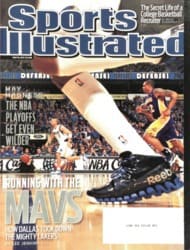
The DiMaggio Enigma
Andre Ethier, the Dodgers' rightfielder whose hitting streak was stopped at 30 games last Saturday, says that he has been aware of Joe DiMaggio's record of hitting safely in 56 straight games since he was "a really little kid." DiMaggio's run began exactly 70 years ago this Sunday, and the closest anyone has come is Pete Rose, with 44 in 1978, which begs a question: Is it more difficult to put together a long streak today than it was in DiMag's time?
"Maybe it's harder now because of the scouting and the technology that teams have," Ethier offers. "It's not just knowing how to pitch you but also how to play you defensively. They didn't really have that then, right?"
Right. There was no video to scrutinize in 1941 and no metrics by which to measure, say, the location of balls put in play. The book that pitchers had on hitters was vague and based on memory and intuition.
Most modern players agree that streaking is harder now. Many point out that baseball is in an era of extreme pitcher specialization. "You'll face four pitchers in a game, including a closer and some kind of setup guy or tricky lefthander who you've seen only once in your career," says former big leaguer Robin Ventura. Right again. DiMaggio faced 55 pitchers over the course of his 56 games. Ethier, in his 30-gamer, faced 62.
But the notion that streaking is harder now has grown into a myth of Loch Ness Monster proportions. There's no evidence to support it. It's not as if players were reeling off 50-game hitting streaks in the 1930s and '40s; DiMaggio squashed a record of 44 straight games that had been set in 1897 by Wee Willie Keeler. Rather, we appear to be in a golden age for hitting streaks right now.
Ethier's was the sixth streak of 30 games or longer since 2005. There were also six such streaks between 1996 and '99. What's more, of the 54 hitting streaks of 30-plus games in baseball history—going back 135 years to 1876—17 of them, or more than 30%, have unfolded in just the last 25 seasons.
That's not simply explained, either. You can't say that hitting is easier now. (The major league batting average in 1941 was .262. Last year it was .257.) But hitting streaks defy probabilistic explanation. Scores of mathematicians have tried to determine how likely a 56-game hitting streak is, and their results vary wildly—once every 746 years, said one study; once every 18,519 years, said another. Even when the predictions are applied to 30- and 35-game streaks, they don't match reality.
I call this the DiMaggio Enigma. What it gets to is that a hitting streak—and not just in a summer like 1941 when a fragile, war-bound nation turned its eyes to DiMaggio—occurs under such unusual circumstances as to be inscrutable. A batter's approach changes. An opposing pitcher's response changes. Things like walks, normally good for a hitter, are bad for a streak. Everything is heightened.
For his part, Ethier seemed to enjoy it all, pleased that he would, at the least, "be the answer to a trivia question." To wit: After Willie Davis's 31 consecutive games in 1969, who has the second-longest hitting streak in Dodgers history?
SI Senior Editor Kostya Kennedy is the author of 56: Joe DiMaggio and the Last Magic Number in Sports (Sports Illustrated Books).
PHOTO
CHUCK SOLOMON
NOT HISTORIC, BUT NOT BAD Ethier (above) got little more than halfway to the mark eventually set by DiMaggio.
PHOTO
CORBIS
[See caption above]

